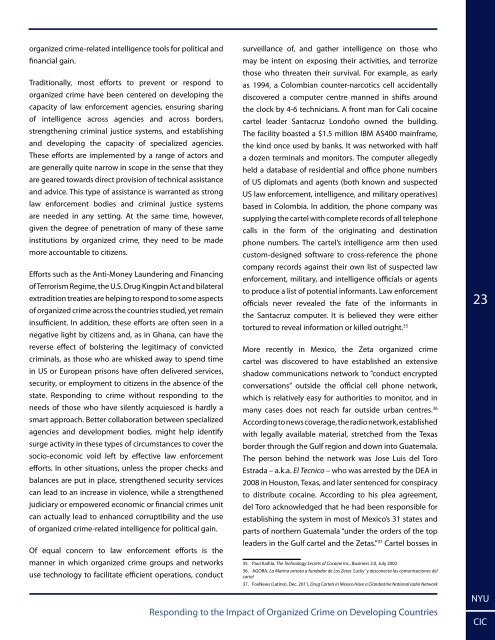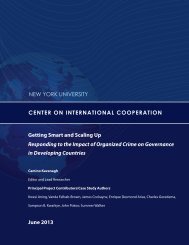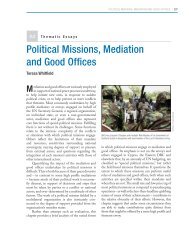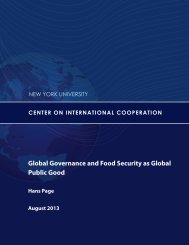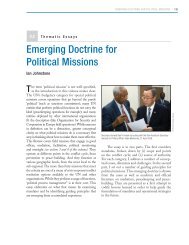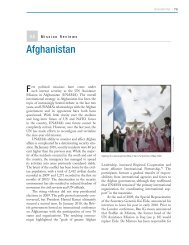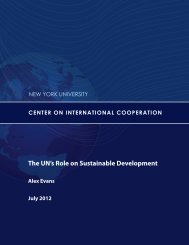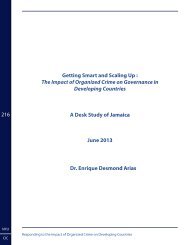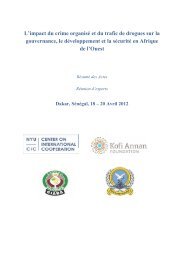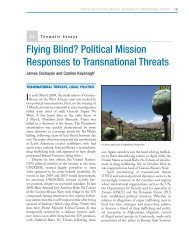here - Center on International Cooperation - New York University
here - Center on International Cooperation - New York University
here - Center on International Cooperation - New York University
Create successful ePaper yourself
Turn your PDF publications into a flip-book with our unique Google optimized e-Paper software.
organized crime-related intelligence tools for political and<br />
financial gain.<br />
Traditi<strong>on</strong>ally, most efforts to prevent or resp<strong>on</strong>d to<br />
organized crime have been centered <strong>on</strong> developing the<br />
capacity of law enforcement agencies, ensuring sharing<br />
of intelligence across agencies and across borders,<br />
strengthening criminal justice systems, and establishing<br />
and developing the capacity of specialized agencies.<br />
These efforts are implemented by a range of actors and<br />
are generally quite narrow in scope in the sense that they<br />
are geared towards direct provisi<strong>on</strong> of technical assistance<br />
and advice. This type of assistance is warranted as str<strong>on</strong>g<br />
law enforcement bodies and criminal justice systems<br />
are needed in any setting. At the same time, however,<br />
given the degree of penetrati<strong>on</strong> of many of these same<br />
instituti<strong>on</strong>s by organized crime, they need to be made<br />
more accountable to citizens.<br />
Efforts such as the Anti-M<strong>on</strong>ey Laundering and Financing<br />
of Terrorism Regime, the U.S. Drug Kingpin Act and bilateral<br />
extraditi<strong>on</strong> treaties are helping to resp<strong>on</strong>d to some aspects<br />
of organized crime across the countries studied, yet remain<br />
insufficient. In additi<strong>on</strong>, these efforts are often seen in a<br />
negative light by citizens and, as in Ghana, can have the<br />
reverse effect of bolstering the legitimacy of c<strong>on</strong>victed<br />
criminals, as those who are whisked away to spend time<br />
in US or European pris<strong>on</strong>s have often delivered services,<br />
security, or employment to citizens in the absence of the<br />
state. Resp<strong>on</strong>ding to crime without resp<strong>on</strong>ding to the<br />
needs of those who have silently acquiesced is hardly a<br />
smart approach. Better collaborati<strong>on</strong> between specialized<br />
agencies and development bodies, might help identify<br />
surge activity in these types of circumstances to cover the<br />
socio-ec<strong>on</strong>omic void left by effective law enforcement<br />
efforts. In other situati<strong>on</strong>s, unless the proper checks and<br />
balances are put in place, strengthened security services<br />
can lead to an increase in violence, while a strengthened<br />
judiciary or empowered ec<strong>on</strong>omic or financial crimes unit<br />
can actually lead to enhanced corruptibility and the use<br />
of organized crime-related intelligence for political gain.<br />
Of equal c<strong>on</strong>cern to law enforcement efforts is the<br />
manner in which organized crime groups and networks<br />
use technology to facilitate efficient operati<strong>on</strong>s, c<strong>on</strong>duct<br />
surveillance of, and gather intelligence <strong>on</strong> those who<br />
may be intent <strong>on</strong> exposing their activities, and terrorize<br />
those who threaten their survival. For example, as early<br />
as 1994, a Colombian counter-narcotics cell accidentally<br />
discovered a computer centre manned in shifts around<br />
the clock by 4-6 technicians. A fr<strong>on</strong>t man for Cali cocaine<br />
cartel leader Santacruz L<strong>on</strong>doño owned the building.<br />
The facility boasted a $1.5 milli<strong>on</strong> IBM AS400 mainframe,<br />
the kind <strong>on</strong>ce used by banks. It was networked with half<br />
a dozen terminals and m<strong>on</strong>itors. The computer allegedly<br />
held a database of residential and office ph<strong>on</strong>e numbers<br />
of US diplomats and agents (both known and suspected<br />
US law enforcement, intelligence, and military operatives)<br />
based in Colombia. In additi<strong>on</strong>, the ph<strong>on</strong>e company was<br />
supplying the cartel with complete records of all teleph<strong>on</strong>e<br />
calls in the form of the originating and destinati<strong>on</strong><br />
ph<strong>on</strong>e numbers. The cartel’s intelligence arm then used<br />
custom-designed software to cross-reference the ph<strong>on</strong>e<br />
company records against their own list of suspected law<br />
enforcement, military, and intelligence officials or agents<br />
to produce a list of potential informants. Law enforcement<br />
officials never revealed the fate of the informants in<br />
the Santacruz computer. It is believed they were either<br />
tortured to reveal informati<strong>on</strong> or killed outright. 35<br />
More recently in Mexico, the Zeta organized crime<br />
cartel was discovered to have established an extensive<br />
shadow communicati<strong>on</strong>s network to “c<strong>on</strong>duct encrypted<br />
c<strong>on</strong>versati<strong>on</strong>s” outside the official cell ph<strong>on</strong>e network,<br />
which is relatively easy for authorities to m<strong>on</strong>itor, and in<br />
many cases does not reach far outside urban centres. 36<br />
According to news coverage, the radio network, established<br />
with legally available material, stretched from the Texas<br />
border through the Gulf regi<strong>on</strong> and down into Guatemala.<br />
The pers<strong>on</strong> behind the network was Jose Luis del Toro<br />
Estrada – a.k.a. El Tecnico – who was arrested by the DEA in<br />
2008 in Houst<strong>on</strong>, Texas, and later sentenced for c<strong>on</strong>spiracy<br />
to distribute cocaine. According to his plea agreement,<br />
del Toro acknowledged that he had been resp<strong>on</strong>sible for<br />
establishing the system in most of Mexico’s 31 states and<br />
parts of northern Guatemala “under the orders of the top<br />
leaders in the Gulf cartel and the Zetas.” 37 Cartel bosses in<br />
35. Paul Kaihla, The Technology Secrets of Cocaine Inc., Business 2.0, July 2002<br />
36. AGORA, La Marina arresta a fundador de Los Zetas ‘Lucky’ y desc<strong>on</strong>ecta las comunicaci<strong>on</strong>es del<br />
cartel<br />
37. Fox<strong>New</strong>s (Latino), Dec. 2011, Drug Cartels in Mexico Have a Clandestine Nati<strong>on</strong>al radio Network<br />
23<br />
Resp<strong>on</strong>ding to the Impact of Organized Crime <strong>on</strong> Developing Countries<br />
NYU<br />
CIC


